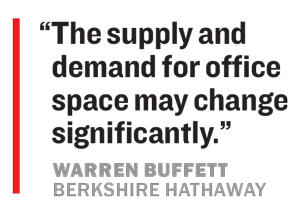The lobby inside the Milstein family’s office building next to Grand Central Terminal looks like something from a tech influencer’s Instagram account. Intimately arranged lounge seating and workstations, canopied by large plants, are flanked by trendy amenities, including a bar, a library-like study area and an amphitheater.
The grand lobby of the 1.1 million-square-foot tower is the result of a $100 million renovation the Milsteins unveiled two years ago at 335 Madison — designed as a selling point for commercial tenants, including Facebook, that want their employees to interact face to face.
But as building owners across New York and other major cities prepare for workers to return from their Covid-19 seclusions, open floor plans and common areas present challenges in the era of social distancing.
“Lobbies are going to go from places where landlords wanted tenants to congregate to, candidly, places where the fewer people congregating, the better,” Bruce Mosler, chairman of global brokerage at Cushman & Wakefield, said about the short-term impact across properties.
A representative for Milstein declined to comment on the landlord’s plans to operate the 29-story building once New York City’s roughly 1.5 million office workers start heading back to work.
But it’s a question that building owners and property managers across the country are now grappling with: How can people safely return to buildings that in many cases were designed to pack employees in as closely as possible?
Property managers are coming up with tight schedules to stagger tenants’ arrival times to avoid the typical morning rush, limit the number of passengers who can ride in an elevator while avoiding long waits, and allow them to vigorously clean high-touch areas like doors, fixtures and turnstiles.
 And they’re doing so under the specter of potential future coronavirus outbreaks once people return — as well as an existential threat that some office tenants may decide working from home is more efficient than leasing large spaces.
And they’re doing so under the specter of potential future coronavirus outbreaks once people return — as well as an existential threat that some office tenants may decide working from home is more efficient than leasing large spaces.
Pre-pandemic, average office rents in Manhattan were just over $80 a square foot with some paying as much as $100 and up, according to CBRE. In other major office markets like Chicago and Washington, D.C., average asking rent figures were $42.93 and $59.58 during the first quarter, according to the brokerage.
Kathryn Wylde of the Partnership for New York City, which represents more than 100 of the city’s largest private companies, said offices are going to require major overhauls when workers return.
“There’s going to be a lot of design changes, different protocol,” Wylde said. “They’re going to need more square footage. They’re going to need different layouts. They’re going to need different partitions.”
Intangible efforts
The Empire State Building is considering installing an air-filtration system that uses polarized ions to neutralize viruses and other contaminants in the air for its famed observatory.
The technology’s proponents say it’s been proven effective at reducing the presence of viruses like the swine flu and SARS and should help to reduce the risk of spreading the coronavirus.
“As far as our technology is concerned, it’s not a silver bullet,” said Steve Levine of AtmosAir, the company installing the system in the iconic skyscraper. “You give yourself one more layer of overall protection.”
 Empire State Realty Trust CEO Anthony Malkin said the building will take other precautions, such as requiring all visitors to be pre-registered.
Empire State Realty Trust CEO Anthony Malkin said the building will take other precautions, such as requiring all visitors to be pre-registered.
“It’s going to be like Studio 54,” he said. “If you’re not on the list, you don’t get in.”
While building owners in New York expect a phased return with only a portion of companies’ workforces to come back in the initial stages, it’s not exactly clear how and when that will happen.
Gov. Andrew Cuomo is starting the process of reopening the state, laying out four phases for different kinds of companies to reopen. He said the state’s various regions will begin based on reaching certain health benchmarks but added it will be “a long time” for the New York City area to get there.
Even then, some office tenants seem hesitant to hurry back. The tech company Slack, for instance, said it plans to return employees to its offices in September. Zillow CEO Rich Barton told his 5,000-plus employees in April that they can work from home through the rest of 2020.
“I would not expect office workers to be back for the most part before September,” Wylde said in reference to New York City.
Some major landlords, however, are preparing for an earlier return. RXR Realty’s Scott Rechler, for one, said he’s getting his buildings ready for workers to come back in the first half of June. He noted that one of the major challenges is reducing the number of touch points that could help spread the virus.
“We’re going touchless as much as possible,” Rechler said. “On Day 1 we might have to keep the doors physically open.”
Big commercial brokerages like Cushman & Wakefield, JLL and Newmark Knight Frank are advising landlord and tenant clients on how to reconfigure their spaces, where maintaining a 6-foot free zone around each person will be the new norm.
Suggestions include removing interior doors completely so workers aren’t constantly touching handles; removing every other chair from seating areas or “checkerboarding” workstations to create more room; and even conducting in-office staff meetings via video so that employees can Zoom in from different conference rooms.
 Some solutions seem alien to normal work life.
Some solutions seem alien to normal work life.
“In Asia, we’ve seen people get in elevators and turn toward the wall,” said Cushman & Wakefield’s tri-state president John Santora. “Now you can’t make people turn away. It all depends on someone’s individual comfort level.”
Some building owners are planning to use back doors or freight entrances to relieve pressure on main lobbies. Others will bar visitors to buildings and require food deliveries to be picked up outside.
And then there’s the issue of what to do with sick tenants. Some building managers plan to use infrared thermometers to check for elevated temperatures — a practice that raises questions about personal privacy.
John Gilbert, chief operating officer of Rudin Management’s smart-building management system Nantum, said he’ll start by conveying to tenants that they need to ask workers who show any signs of infection to stay at home.
Rudin will also enforce safety protocols, such as having building staff make sure people are maintaining proper social distancing, Gilbert noted.
“No one’s going to be allowed into a Rudin building without a mask,” he said. “Our security guards are going to become foot traffic cops.”
Existential crises
Looming over the immediate challenge of returning tenants to work is a broader threat to office buildings.
Twitter sparked a frenzy on the internet in Mid-May after its CEO Jack Dorsey told staffers in an email that some of them would be able to permanently work from home, even after the crisis is over.
Many companies are finding that they have effectively transitioned their employees to working from home, and many see the significant costs of leasing large swaths of office space as a budget item that can be reduced in the future.
Among others, Morgan Stanley’s James Gorman and BlackRock’s Larry Fink have said they can see a future where companies keep a large portion of employees working remotely.
“The supply and demand for office space may change significantly,” Warren Buffett said at Berkshire Hathaway’s annual investors meeting, which was held remotely in April.
“A lot of people have learned that they can work at home, or that there’s other methods of conducting their business than they might have thought from what they were doing a couple of years ago,” he added. “When change happens in the world, you adjust to it.”
If a meaningful shift toward more work-from-home policies results in tenants taking less space, that could drive down office rents and property values.
Of course, the real estate industry has faced similar threats before. With the dot-com boom of the late 1990s and early 2000s, many predicted teleconferencing would be the future of work. And again after the terrorist attacks of 9/11, many worried that companies would be too frightened to return to Manhattan skyscrapers.
For now, the debate appears to be breaking down along ideological lines.
Ronald Dickerman, president of the real estate private equity firm Madison International Realty, said the latest views around social distancing could encourage companies to take more space. For years, tenants had densified their offices, packing more employees per square foot into open office plans, or going even further to line workers up side by side on long benches or rotate multiple employees through the same workspace through “hot desking.”
He and others believe that trend had already started to reverse before the virus pandemic and could be accelerated now. “I do not think the office building is a dinosaur,” Dickerman said.
Joe Du Bey, CEO of the office management startup Eden, said the largest companies can most likely afford expensive reconfigurations to their spaces — whether it’s putting up plexiglass partitions and redesigning their floor plans or taking more square footage per employee. For smaller companies, he said, it may not be economically feasible.
Du Bey added that most companies will have their convictions one way or another.
“I think it’s going to be more of a binary conversation,” he said. “Are you a company with an office or not?”
